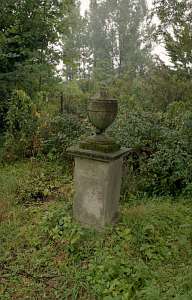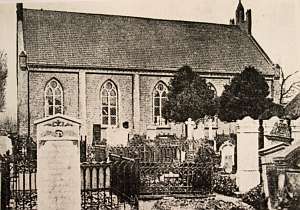|
gm. Nowy Dwór Gdański, pow. nowodworski, woj. pomorskie
Until 1945 Tiegenhagen TK (Gotha, Endersch, Schrötter)

The village was granted the Chełmno rights in 1352 by Winricha von Kniprode. It had 60 włókas. The parish was established at the same time. A section of the St. Nicolas church was probably erected as early as the 14th century. Its western section has a half-timbered structure, while the eastern section is made of brick. The building was renovated, but some of the walls still have a tenon-post structure. A wooden tower was erected on the lower brick section multiple times, but after its destruction in 1945, it has not been reconstructed. A re-development of the Cyganek area began in 1550. In 1676, the settlers paid rent from 50 włókas and 4 morgas of land. Ca. 1640, the village was established as a Mennonite religious center for this section of Żuławy. The Mennonite center of the Żelichów-Cyganek area was under the authority of the Flemish community Wielkie Żuławy in Gdańsk. In 1735, the center, including Różany, Orłowo, and NiedĽwiedzica, formed an independent community. In 1814, Abraham Wiebe from the local community also served as an elder for the other 4 communities. In 1727, there were 60 Mennonites in the area, in 1764 - 46, and in 1772 - 45. In 1768, the community received a permission from the Chełmno bishop to erect a wooden church. The church was erected shortly afterwards. In 1892-93, it was replaced by a masonry church. In 1885, the area of the village equaled 1074 ha; the village had 78 houses, 671 Catholics and Lutherans, and 198 Mennonites. Village layout - flood bank Reihendorf (row) village located on the western bank of the Tuga - ca. 8 small farms and a single-homestead village located on the western side of the Nowy Dwór-Stegna road - 13 farms; the village had a church surrounded by a cemetery (northern section of the village) and a Mennonite cemetery and a church (the southern section). The cultural landscape has been severely transformed. Practically, no homesteads have survived in the western section of the village. However, there are several historical houses by the Tuga’s flood bank. The Mennonite church was demolished after 1945. The Mennonite cemetery has been sporadically cleaned. The St. Nicolas church has survived, and currently serves as a Greek Catholic church. A lapidarium - open air museum is currently being established in the second Mennonite cemetery. It is also to include other recovered gravestones. There are plans (project stage) to transfer an arcaded house and a draining windmill to the village.
A building without a number is a house from a Dutch homestead
(farm building have been demolished). It dates from the 3rd quarter of the
19th century. It is located in the southern section of the village, on the
eastern side of the road, facing it with its gable. It has a high brick
underpinning, a log structure with quoins covered by boards imitating
Tuscan pilaster, a boarded gable, and a tile roof. The gable elevation has
3 axes, a 4-axial gable, two wide windows enclosed by two smaller
rectangular windows, and a similar form of side windows above. The western
elevation has 5 axes and a central entrance with a masonry
porch.
The church cemetery was also used by the Mennonites until
they established their own cemetery near Nowy Dwór and then a second one -
north of the church. Several historical gravestones (also in the form of
cippus with an urn) have survived.
  Next to the church, there is a
small cemetery (unidentified layout) with 3 preserved stalls. The
only known wooden stall was found in this cemetery. The stall has been
restored and currently is on display in the Muzeum Żuławskie in Nowy Dwór
Gdański. Currently, a lapidarium is being established. It will display
recently found gravestones of Klassen (1696), Abraham Siemens (1748),
Peter Classen (1727), another Peter Classen (1728), Peter Kelpin, and
Johan Bestvader’s stall. Next to the church, there is a
small cemetery (unidentified layout) with 3 preserved stalls. The
only known wooden stall was found in this cemetery. The stall has been
restored and currently is on display in the Muzeum Żuławskie in Nowy Dwór
Gdański. Currently, a lapidarium is being established. It will display
recently found gravestones of Klassen (1696), Abraham Siemens (1748),
Peter Classen (1727), another Peter Classen (1728), Peter Kelpin, and
Johan Bestvader’s stall.
 The Mennonite cemetery in the southern
section of the village is located in the Tuga river bent - ca. 200 m to
the east of the Nowy Dwór Gdański - Stegna road, on a slight artificial
rise. The cemetery has a rectangular layout with a linden trees along the
edges and alleys (the main alley in the entrance axis and two crosswise
alleys). Some of the most impressive gravestones were transferred to the
Museum in Nowy Dwór Gdański. Only a memorial stone and concrete frames of
graves have remained. Foundations of an old church are detectable in the
southeastern section. The Mennonite cemetery in the southern
section of the village is located in the Tuga river bent - ca. 200 m to
the east of the Nowy Dwór Gdański - Stegna road, on a slight artificial
rise. The cemetery has a rectangular layout with a linden trees along the
edges and alleys (the main alley in the entrance axis and two crosswise
alleys). Some of the most impressive gravestones were transferred to the
Museum in Nowy Dwór Gdański. Only a memorial stone and concrete frames of
graves have remained. Foundations of an old church are detectable in the
southeastern section.
 The traditional wooden Mennonite church
was replaced in 1892-93. The building had a rectangular layout, a single
nave, and a brick structure. The roof was covered with interlocking or
plain tiles. The building had an open interior with galleries suspended
from three sides. Side elevations were enclosed by lesenes; they had 5
high windows with pointed arches with tracery. The frontal elevation had a
triangular gable with crow steps in the finial, a pointed-arch arcade in
the axis, a frieze of pointed-arch arcades along edges, a centrally
located entrance with a high pointed-arch heavy portal, rich rosette with
tracery and a pair of pointed-arch windows located above the portal. The traditional wooden Mennonite church
was replaced in 1892-93. The building had a rectangular layout, a single
nave, and a brick structure. The roof was covered with interlocking or
plain tiles. The building had an open interior with galleries suspended
from three sides. Side elevations were enclosed by lesenes; they had 5
high windows with pointed arches with tracery. The frontal elevation had a
triangular gable with crow steps in the finial, a pointed-arch arcade in
the axis, a frieze of pointed-arch arcades along edges, a centrally
located entrance with a high pointed-arch heavy portal, rich rosette with
tracery and a pair of pointed-arch windows located above the portal.
SGKP, t. XII, s. 337; Penner, s. 48, 84-85; ME, t. IV, s. 329, Lipińska t. III, poz. 185; AG; BF
|


 Next to the church, there is a
small cemetery (unidentified layout) with 3 preserved stalls. The
only known wooden stall was found in this cemetery. The stall has been
restored and currently is on display in the Muzeum Żuławskie in Nowy Dwór
Gdański. Currently, a lapidarium is being established. It will display
recently found gravestones of Klassen (1696), Abraham Siemens (1748),
Peter Classen (1727), another Peter Classen (1728), Peter Kelpin, and
Johan Bestvader’s stall.
Next to the church, there is a
small cemetery (unidentified layout) with 3 preserved stalls. The
only known wooden stall was found in this cemetery. The stall has been
restored and currently is on display in the Muzeum Żuławskie in Nowy Dwór
Gdański. Currently, a lapidarium is being established. It will display
recently found gravestones of Klassen (1696), Abraham Siemens (1748),
Peter Classen (1727), another Peter Classen (1728), Peter Kelpin, and
Johan Bestvader’s stall. The Mennonite cemetery in the southern
section of the village is located in the Tuga river bent - ca. 200 m to
the east of the Nowy Dwór Gdański - Stegna road, on a slight artificial
rise. The cemetery has a rectangular layout with a linden trees along the
edges and alleys (the main alley in the entrance axis and two crosswise
alleys). Some of the most impressive gravestones were transferred to the
Museum in Nowy Dwór Gdański. Only a memorial stone and concrete frames of
graves have remained. Foundations of an old church are detectable in the
southeastern section.
The Mennonite cemetery in the southern
section of the village is located in the Tuga river bent - ca. 200 m to
the east of the Nowy Dwór Gdański - Stegna road, on a slight artificial
rise. The cemetery has a rectangular layout with a linden trees along the
edges and alleys (the main alley in the entrance axis and two crosswise
alleys). Some of the most impressive gravestones were transferred to the
Museum in Nowy Dwór Gdański. Only a memorial stone and concrete frames of
graves have remained. Foundations of an old church are detectable in the
southeastern section. The traditional wooden Mennonite church
was replaced in 1892-93. The building had a rectangular layout, a single
nave, and a brick structure. The roof was covered with interlocking or
plain tiles. The building had an open interior with galleries suspended
from three sides. Side elevations were enclosed by lesenes; they had 5
high windows with pointed arches with tracery. The frontal elevation had a
triangular gable with crow steps in the finial, a pointed-arch arcade in
the axis, a frieze of pointed-arch arcades along edges, a centrally
located entrance with a high pointed-arch heavy portal, rich rosette with
tracery and a pair of pointed-arch windows located above the portal.
The traditional wooden Mennonite church
was replaced in 1892-93. The building had a rectangular layout, a single
nave, and a brick structure. The roof was covered with interlocking or
plain tiles. The building had an open interior with galleries suspended
from three sides. Side elevations were enclosed by lesenes; they had 5
high windows with pointed arches with tracery. The frontal elevation had a
triangular gable with crow steps in the finial, a pointed-arch arcade in
the axis, a frieze of pointed-arch arcades along edges, a centrally
located entrance with a high pointed-arch heavy portal, rich rosette with
tracery and a pair of pointed-arch windows located above the portal.